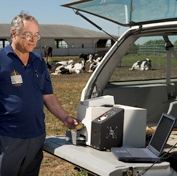Prototype machine quickly detects nitrogen and water levels in manure

A prototype manure-analysing device that works off a car or truck battery has been built by an Agricultural Research Service (ARS) scientist.
Chemist James B Reeves designed the portable, easy-to-use analyser so farmers can quickly tell how much nitrogen and water are in a sample of manure.
Many farmers apply manure to their crops as an organic fertiliser, but it can sometimes be too much of a good thing. They apply too much because they’re not sure how much nitrogen or phosphorus might be in it and decide to err on the side of excess.
But excess nutrients can run off in rainwater and eventually pollute streams, lakes and other bodies of water.
To determine how much nitrogen or phosphorus manure contains, farmers can send samples to a laboratory for analysis, but that takes time and money. And they usually send only one sample from the large pit into which they flush their manure. According to Reeves, a one-sample analysis can’t reflect the nutrient levels that often vary throughout a manure pit.
The prototype analyser passes invisible, near-infrared light through filters onto about two tablespoons of manure placed in a small cup. The amount of light reflected back allows a filter spectrometer to quantify both the nitrogen and water content. Manure samples require no preparation or chemicals, and the analysis takes about a minute.
Having access to an accurate, inexpensive manure analyser will become even more important to farmers if nutrient-management regulations tighten further. The prototype analyser is a 15-inch cube that weighs about 20 pounds. Reeves plans to make it even smaller – about the size of a shoebox and weighing around 5 pounds.
Read more about the research in the July 2006 issue of Agricultural Research magazine.













